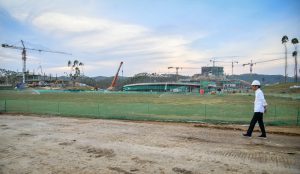For an emerging country long aspiring to signify its socio-economic transformation through the high-speed rail system, Thailand’s decision to select China as a partner is no coincidence. China’s more than 42,000 kilometers of rail lines built only in recent decades are undeniably remarkable and have become the world’s longest and most extensively used. Moreover, the construction cost is relatively cheap compared to its Japanese or European counterparts. This can be attributed to several factors: cheap labor, the government’s absolute power in dealing with land acquisition, and economies of scale, to name a few. Most importantly, safety has not been compromised despite much lower construction costs.
Unsurprisingly, the governments of emerging ASEAN nations like Laos and Indonesia picked the Chinese model for their high-speed rail projects. Thailand followed suit under Prayut Chan-o-cha’s administration in 2014 by signing an MOU with China. Tens of meetings then took place between officials from the two governments to discuss the details and negotiate financing terms for the investment.

Unfortunately, it eventually turned out that finding common ground on funding was rather difficult. Taking loans from the Export-Import Bank of China with a 3% interest rate was not profitable, while borrowing from domestic sources offered a lower rate of 2%. The necessity for Chinese loans is, thus, minimal because Thailand’s relatively strong financial sector gives access to domestic funding.
Two other important reasons exist behind the decision to avoid Chinese loans and fund the investment domestically. The first is the deliberate attempt to prevent what many may call “debt-trap diplomacy.” While this debt-trap concept is unlikely to be accurate, the anti-Chinese sentiment apparently does exist. Borrowing from China, even for a tiny amount, could be frowned upon by the general public and media in Thailand, undermining the political support. This also explains why the Thai government has yet to borrow from China under the Belt and Road Initiative (BRI).
The second concerns the legacy of the 1997-98 Asian Financial Crisis. The remnants and recollections of the crisis make those in the government and financial market afraid of external borrowing with possible negative impacts of currency mismatches, as observed with Thailand’s foreign-currency public debt accounting for only 1.6% of the total.
The next question is what else but “connectivity” Beijing stands to gain when its loans play no role and whether its partnership with the Thais can justify a critical technology transfer. One can easily observe a power play between Bangkok and Beijing. As much as Thai people long for their first high-speed rail line, the Chinese government wants Thailand to choose its high-speed rail model over other countries. With its strategic location at the heart of mainland Southeast Asia, Thailand is critical for China to see its high-speed rail system expand from Yunnan province to Indochina and eventually reach the Malay Peninsula via a revived Kuala Lumpur-Singapore project.
There are two key benefits for Beijing. First, Thailand adopting Chinese technology for its first high-speed rail line will likely continue using China’s trains and construction techniques for its subsequent high-speed rail investments because of economies of scale and the familiarity for those who will work on constructing and operating the lines. Second, Thailand’s precedent will impact its neighbors in today’s highly interconnected world with freer flows of goods and services. The nations around Thailand may also choose Chinese trains to make every transportation step to or through Thailand as smooth as possible.
Aware of the benefits for China, the Thai government used its “strategic location” trump card and leveraged this during negotiations to win an agreement for Beijing to transfer its critically important technology without taking China’s loans, unlike Laos and Indonesia.
Putting smaller countries on an equal footing with major powers is not easy. This Thai high-speed rail case has involved the side effects of significant project delays. Nonetheless, it helps ensure relatively smaller and more capable countries stand to gain more. One may simply call this a “slow but steady” approach. After all, Bangkok needs Beijing to build high-speed trains that are safe, efficient, and, most importantly, affordable, just as much as Beijing needs Bangkok to promote economic growth and gain political influence through the critical technology in Thailand at the heart of Southeast Asia.

The final question is whether other smaller countries can replicate this approach when negotiating with major powers. The answer is yes, but they must understand that this high-speed rail project is yet to be completed and cannot be guaranteed success. In fact, without financially and legally binding agreements, the Thai-Chinese partnership can be considered as fragile.
Technology transfers have been agreed only in principle and still heavily depend on various conditions, such as reviewing China’s high-speed rail standards and the qualifications of Chinese engineers and architects. Even though construction of the line’s first phase between Bangkok and Nakhon Ratchasima has already begun, its 15% completion as of late 2022 is only a fragment of the entire project.
In addition, while China has enjoyed a much lower construction cost with few land acquisition problems and economies of scale, other countries, including Thailand, may not, even with the Chinese model. China, a uniquely huge country with ample financial resources, was able to reap the benefits of economies of scale by building several high-speed rail lines simultaneously. This contrasts with countries like Thailand and Indonesia, where only one high-speed rail line is currently being built. Likewise, unlike a single-party state with the government’s absolute power, land acquisition is more challenging, and political changes mean any earlier administration’s commitments could fade away.
Most importantly, other countries will need to consider their contexts, which may differ from Thailand’s, such as their location and domestic financial sector. Nevertheless, regardless of the Thai mega project’s success or failure, the investment, coupled with a series of battling negotiations with major powers like China, will become a successful use of game-changing cards to set an example for those countries to put themselves on a more equal footing with major powers.
(Image by storyset on Freepik)
This student blogpost is originally written as an assignment for the course “Asia’s Geoeconomic Landscapes and Public Policy I” offered in the academic year 2023, representing the author’s personal views on the subject. The author was inspired and benefited from a discussion with his classmates, Prof. Shiro Armstrong from the Australian National University’s Crawford School of Public Policy, and Prof. Toshiro Nishizawa from GraSPP.



